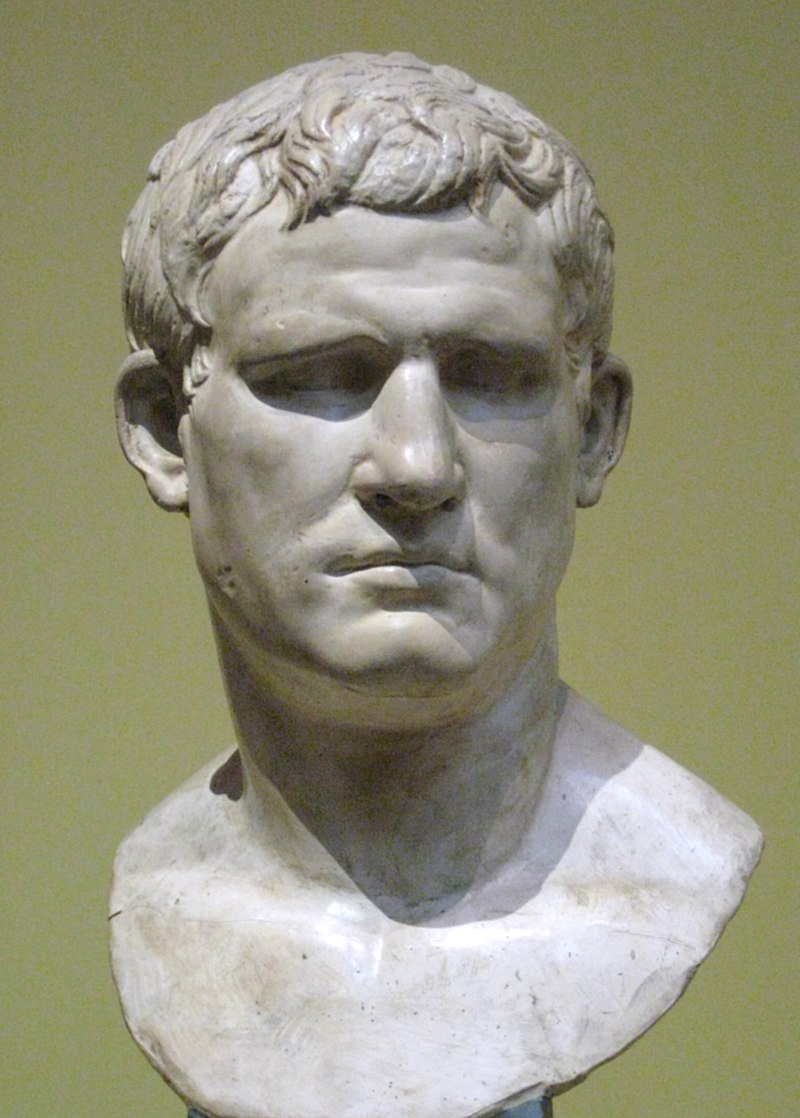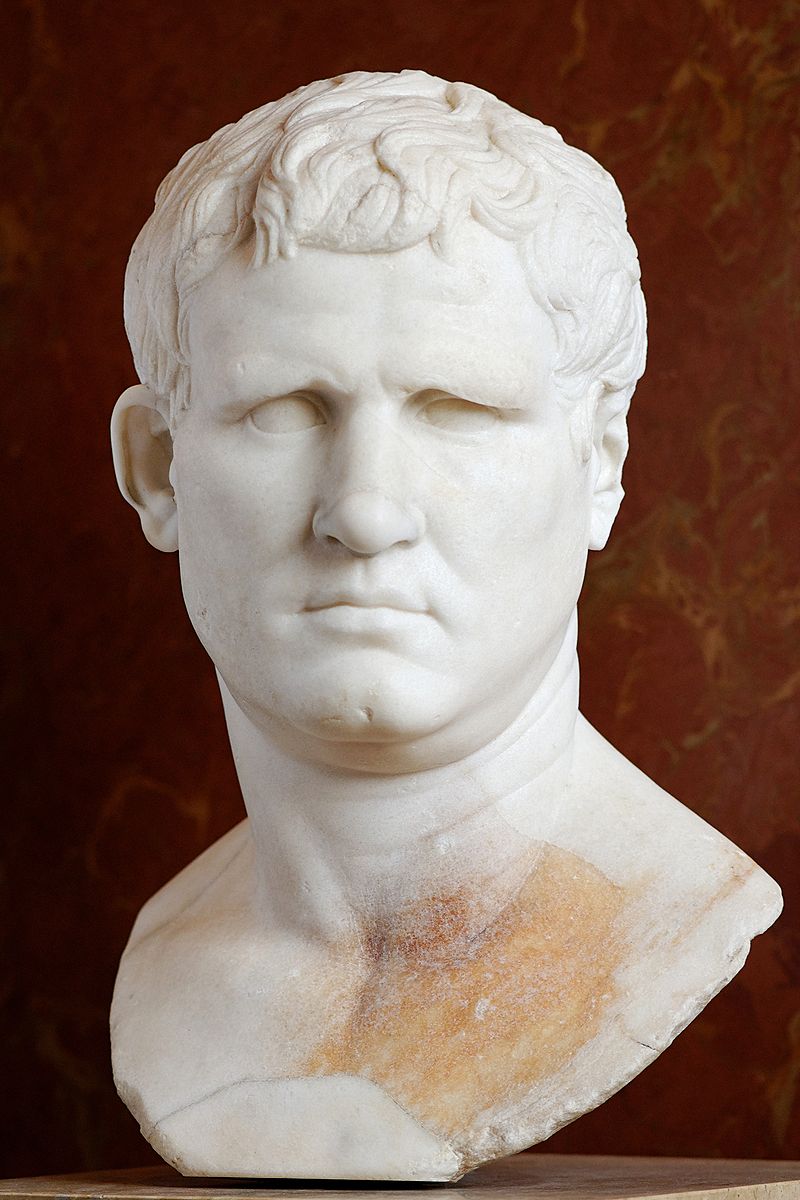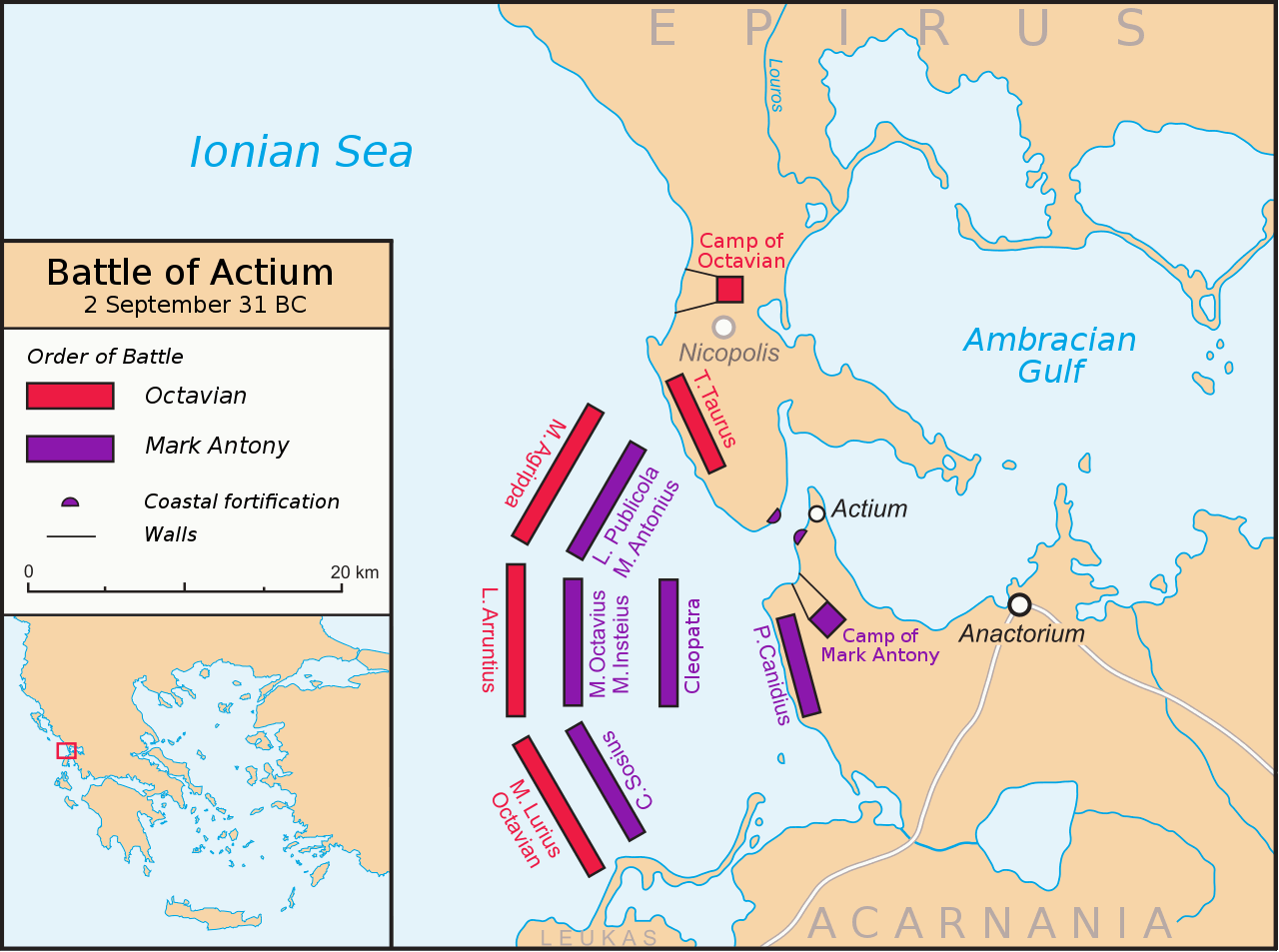

Marble
busts of Agrippa, capturing the likeness of the Roman general rather well.
Marcus Vipsanius Agrippa (63 BC – 12 BC) was a Roman general, statesman and architect who was a close friend, son-in-law and lieutenant to the Roman emperor Augustus. Agrippa is well known for his important military victories, notably the
Battle of Actium in 31 BC against the forces of
Mark Antony and
Cleopatra. He was also responsible for the construction of some of the most notable buildings of his era, including the original Pantheon.
Born to a plebeian family c. 63 BC, in an uncertain location in Roman
Italy, he met the future emperor Augustus, then known as Octavian, at Apollonia, in Illyria. Following the assassination of Octavian's great-uncle
Julius Caesar in 44 BC, Octavian returned to Italy. Around this time, Agrippa was elected tribune of the plebs. He served as a military commander, fighting alongside Octavian and Caesar's former general and right-hand man Mark Antony in the Battle of Philippi. In 40 BC, he was praetor urbanus and played a major role in the Perusine war against Lucius Antonius and Fulvia, respectively the brother and wife of Mark Antony. In 39 or 38 BC, Agrippa was appointed governor of Transalpine Gaul. In 38 BC, he put down a rising of the Aquitanians and fought the Germanic tribes. He was consul for 37 BC, well below the usual minimum age of 43, to oversee the preparations for warfare against Sextus Pompey, who had cut off grain shipments to Rome.
Agrippa defeated Pompey in the battles of Mylae and Naulochus in 36 BC. In 33 BC, he served as curule aedile. Agrippa commanded the victorious Octavian's fleet at the Battle of Actium in 31 BC. A few years after the victory at Actium, Octavian became emperor and took the title of Princeps, while Agrippa remained as his close friend and lieutenant. Agrippa assisted Augustus in making
Rome "a city of marble". Agrippa renovated aqueducts to provide
Roman citizens from every social class access to the highest quality public services, and was responsible for the creation of many baths, porticoes, and gardens. He was also awarded powers almost as great as those of Augustus. He had veto power over the acts of the Senate and the power to present laws for approval by the People. He died in 12 BC at the age of 50–51. Augustus honored his memory with a magnificent funeral and spent over a month in mourning. His remains were placed in Augustus' own mausoleum.
Agrippa was also known as a writer, especially on geography. Under his supervision,
Julius
Caesar's design of having a complete survey of the empire made was accomplished. From the materials at hand he constructed a circular chart, which was engraved on marble by Augustus and afterwards placed in the colonnade built by his sister Vipsania Polla. Agrippa was also husband to Julia the Elder (who had later married the second Emperor Tiberius), and was the maternal grandfather of Caligula and the maternal great-grandfather of the Emperor Nero.
EARLY CAREER
Agrippa was the same age as Octavian (the future emperor Augustus), and the two were educated together and became close friends. Despite Agrippa's association with the family of
Julius
Caesar, his elder brother chose another side in the civil wars of the 40s BC, fighting under Cato against Caesar in Africa. When Cato's forces were defeated, Agrippa's brother was taken prisoner but freed after Octavian interceded on his behalf.
It is not known whether Agrippa fought against his brother in Africa, but he probably served in Caesar's campaign of 46 to 45 BC against Gnaeus Pompeius, which culminated in the Battle of Munda. Caesar regarded him highly enough to send him with Octavius in 45 BC to study in Apollonia (on the Illyrian coast) with the
Macedonian legions, while Caesar consolidated his power in Rome. In the fourth month of their stay in Apollonia the news of Julius Caesar's assassination in March 44 BC reached them. Agrippa and another friend, Quintus Salvidienus Rufus, advised Octavius to march on Rome with the troops from Macedonia, but Octavius decided to sail to Italy with a small retinue. After his arrival, he learned that Caesar had adopted him as his legal heir. Octavius at this time took Caesar's name, but modern historians refer to him as "Octavian" during this period.
RISE TO POWER - OCTAVIAN'S FRIEND
After Octavian's return to Rome, he and his supporters realised they needed the support of legions. Agrippa helped Octavian to levy troops in Campania. Once Octavian had his legions, he made a pact with Mark Antony and Lepidus, legally established in 43 BC as the Second Triumvirate. Octavian and his consular colleague Quintus Pedius arranged for Caesar's assassins to be prosecuted in their absence, and Agrippa was entrusted with the case against Gaius Cassius Longinus. It may have been in the same year that Agrippa began his political career, holding the position of tribune of the plebs, which granted him entry to the Senate.
In 42 BC, Agrippa probably fought alongside Octavian and Antony in the Battle of Philippi. After their return to Rome, he played a major role in Octavian's war against Lucius Antonius and Fulvia, respectively the brother and wife of Mark Antony, which began in 41 BC and ended in the capture of Perusia in 40 BC. However, Salvidienus remained Octavian's main general at this time. After the Perusine war, Octavian departed for Gaul, leaving Agrippa as urban praetor in Rome with instructions to defend Italy against Sextus Pompeius, an opponent of the Triumvirate who was now occupying Sicily. In July 40 BC, while Agrippa was occupied with the Ludi Apollinares that were the praetor's responsibility, Sextus began a raid in southern Italy. Agrippa advanced on him, forcing him to withdraw. However, the Triumvirate proved unstable, and in August 40 BC both Sextus and Antony invaded Italy (but not in an organized alliance). Agrippa's success in retaking Sipontum from Antony helped bring an end to the conflict. Agrippa was among the intermediaries through whom Antony and Octavian agreed once more upon peace. During the discussions Octavian learned that Salvidienus had offered to betray him to Antony, with the result that Salvidienus was prosecuted and either executed or committed suicide. Agrippa was now Octavian's leading general.
GOVERNOR OF TRANSALPINE GAUL
In 39 or 38 BC, Octavian appointed Agrippa governor of Transalpine Gaul, where in 38 BC he put down a rising of the Aquitanians. He also fought the Germanic tribes, becoming the next Roman general to cross the Rhine after Julius Caesar. He was summoned back to Rome by Octavian to assume the consulship for 37 BC. He was well below the usual minimum age of 43, but Octavian had suffered a humiliating naval defeat against Sextus Pompey and needed his friend to oversee the preparations for further warfare. Agrippa refused the offer of a triumph for his exploits in Gaul – on the grounds, says Dio, that he thought it improper to celebrate during a time of trouble for Octavian.
Since Sextus Pompeius had command of the sea on the coasts of Italy, Agrippa's first care was to provide a safe harbour for Octavian's ships. He accomplished this by cutting through the strips of land which separated the Lacus Lucrinus from the sea, thus forming an outer harbour, while joining the lake Avernus to the Lucrinus to serve as an inner harbor. The new harbor-complex was named Portus Julius in Octavian's honour. Agrippa was also responsible for technological improvements, including larger ships and an improved form of grappling hook. About this time, he married Caecilia Pomponia Attica, daughter of Cicero's friend Titus Pomponius Atticus.
WAR WITH SEXTUS POMPEIUS
In 36 BC, Octavian and Agrippa set sail against Sextus. The fleet was badly damaged by storms and had to withdraw; Agrippa was left in charge of the second attempt. Thanks to superior technology and training, Agrippa and his men won decisive victories at Mylae and Naulochus, destroying all but seventeen of Sextus' ships and compelling most of his forces to surrender. Octavian, with his power increased, forced the triumvir Lepidus into retirement and entered Rome in triumph. Agrippa received the unprecedented honour of a corona navalis decorated with the beaks of ships; as Dio remarks, this was "a decoration given to nobody before or since".
PUBLIC SERVICE
Agrippa participated in smaller military campaigns in 35 and 34 BC, but by the autumn of 34 BC he had returned to Rome. He rapidly set out on a campaign of public repairs and improvements, including renovation of the aqueduct known as the
Aqua Marcia and an extension of its pipes to cover more of the city. He became the first Curator Aquarum of Rome in 33 BC. Through his actions after being elected in 33
BC as one of the aediles (officials responsible for Rome's buildings and festivals), the streets were repaired and the sewers were cleaned out, and lavish public spectacles were held. Agrippa signalled his tenure of office by effecting great improvements in the city of Rome, restoring and building aqueducts, enlarging and cleansing the Cloaca Maxima, constructing baths and porticos, and laying out gardens. He also gave a stimulus to the public exhibition of works of art. It was unusual for an ex-consul to hold the lower-ranking position of aedile, but Agrippa's success bore out that break with tradition. As emperor, Augustus would later boast that "he had found the city of brick but left it of marble" in part because of the great services provided by Agrippa under his reign.

BATTLE
OF ACTIUM
Agrippa was again called away to take command of the fleet when the war with Antony and
Cleopatra broke out. He captured the strategically important city of Methone at the southwest of the Peloponnese, then sailed north, raiding the Greek coast and capturing Corcyra (modern Corfu). Octavian then brought his forces to Corcyra, occupying it as a naval base. Antony drew up his ships and troops at Actium, where Octavian moved to meet him. Agrippa meanwhile defeated Antony's supporter Quintus Nasidius in a naval battle at Patrae. Dio relates that as Agrippa moved to join Octavian near Actium, he encountered Gaius Sosius, one of Antony's lieutenants, who was making a surprise attack on the squadron of Lucius Tarius, a supporter of Octavian. Agrippa's unexpected arrival turned the battle around.
As the decisive battle approached, according to Dio, Octavian received intelligence that
Antony and Cleopatra planned to break past his naval blockade and escape. At first he wished to allow the flagships past, arguing that he could overtake them with his lighter vessels and that the other opposing ships would surrender when they saw their leaders' cowardice. Agrippa objected, saying that Antony's ships, although larger, could outrun Octavian's if they hoisted sails, and that Octavian ought to fight now because Antony's fleet had just been struck by storms. Octavian followed his friend's advice.
On 2 September 31 BC, the Battle of Actium was fought. Octavian's victory, which gave him the mastery of Rome and the empire, was mainly due to Agrippa. Octavian then bestowed upon him the hand of his niece Claudia Marcella Major in 28 BC. He also served a second consulship with Octavian the same year. In 27 BC, Agrippa held a third consulship with Octavian, and in that year, the Senate also bestowed upon Octavian the imperial title of Augustus.
In commemoration of the Battle of Actium, Agrippa built and dedicated the building that served as the Roman Pantheon before its destruction in AD 80. Emperor Hadrian used Agrippa's design to build his own Pantheon, which survives in Rome. The inscription of the later building, which was built c. 125, preserves the text of the inscription from Agrippa's building during his third consulship. The years following his third consulship, Agrippa spent in Gaul, reforming the provincial administration and taxation system, along with building an effective road system and aqueducts.
 
CLONED
REPLICANT - Using the latest technology in computer genome mapping and
digital DNA splicing, a brotherhood of progressive scientists reincarnate Cleopatra
VII, who died in 30BC, having located and plundered her sarcophagus from
its watery grave. The resurrected Pharaoh has to mesh with the modern
world she's been reborn into, against antagonists various, including the
CIA and Vatican.
|




